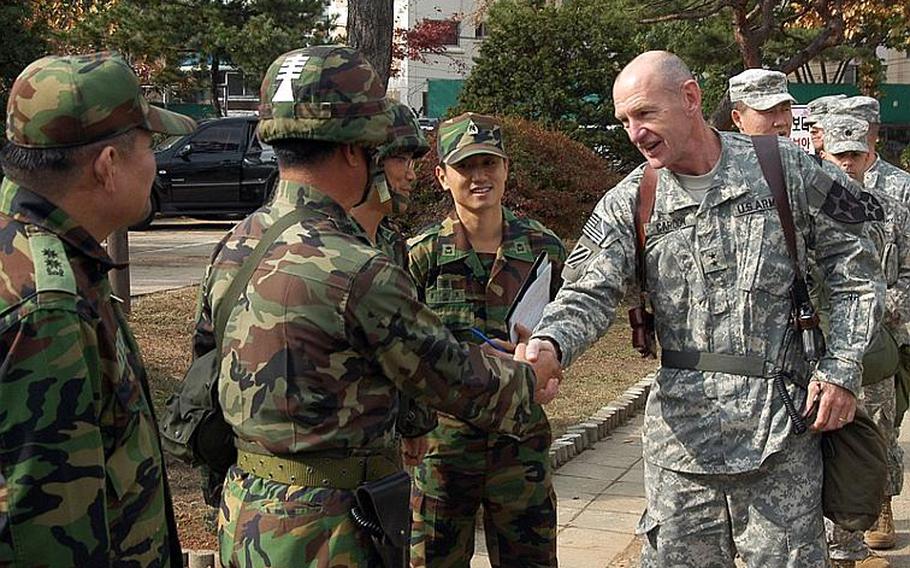
Maj. Gen. Edward C. Cardon, the commander of the 2nd Infantry Division, center, is greeted by South Korean Army personnel as he arrives at a Korean base near Gimpo in November of 2011. (Jon Rabiroff/Stars and Stripes)
CAMP CASEY, South Korea – U.S. and South Korean military officials huddled in operations centers over the past two weeks going over, in great detail, how they would respond to a chemical or biological attack from North Korea.
While many details of the exercise are classified, 2nd Infantry Division officials said the computer-based Warpath III exercise, which was scheduled to end Thursday, gave 1,000 servicemembers from eight American and South Korean brigades experience in how the alliance would react with the “full spectrum” of its manpower and equipment in the event the North made good on threats it has made over the years.
“That threat is real,” 2ID spokesman Lt. Col. Joe Scrocca said. “The regime in North Korea … they claim to have those weapons (and) they’ve threatened to use those weapons.
“I think it would be irresponsible not to take that threat seriously. If we don’t practice, we will not be ready if they use those weapons. We’re practicing for a real-world threat on the peninsula.”
After getting an operations center update Tuesday from participants in the exercise, 2ID commander Maj. Gen. Edward C. Cardon said U.S. and South Korean officials should not be lulled into a false sense of security by conciliatory gestures the North has made in recent months toward the alliance and the rest of the outside world.
“I’m in the security business, where you constantly get surprised,” he said. “So, the best thing you can do is be ready. All we can do is remain as ready as possible and show that we are capable.”
Earlier in the day, as he flew by helicopter between exercise bases of operation at Camp Casey and at a Korean army base near Gimpo, Cardon said it is “an unknown unknown” whether North Korea will continue to present itself as open to negotiations with the U.S. and the South, and to continue to try to distance itself from last year’s sinking of a South Korean warship and shelling of an island near the disputed maritime border between the two Koreas – events that left 50 people dead.
“Our job is to be ready for whatever comes,” the commander said. “We’re in the business of conducting operations with the least … loss of life.”
While North Korea’s developing nuclear weapons program has grabbed the lion’s share of headlines in recent years, those familiar with the North believe its chemical and biological capabilities would be key elements of any all-out attack on the South.
A 2007 Popular Mechanics investigative report stated that, according to defectors, South Korean intelligence agencies and other sources, North Korea has built “one of the world’s most extensive biochemical warfare programs.”
“The weaponry is thought to have the potential to decimate [South Korea] and the 28,000 U.S. troops stationed there,” the story said.
In 2009, The Associated Press reported that it is “widely believed the North has a chemical capability that it could unleash in the early stages of a land war to demoralize defending forces and deny the use of mobilization centers, storage areas and military bases.”
In September, the Yonhap News Agency reported that South Korean lawmaker Shin Hak-yong called for greater efforts to expand the South’s defense against potential biological warfare, saying that North Korea is prepared to spread 13 kinds of biological agents, including anthrax bacterium, the smallpox virus and cholera.
And last month, The Dong-A Ilbo newspaper reported that Bruce Bennett – a senior policy analyst at the U.S.-based RAND Corp. think tank – said as many as 240,000 people would die if North Korea managed to release 10 kilograms of anthrax over Seoul.
Speaking at an international symposium at the Korea Military Academy, Bennett reportedly said the North would use a variety of methods – including missiles, aircraft or special forces – to spread anthrax as the prelude to an attack on South Korea.
Cardon — who recently took over as 2ID commander after serving in Iraq — said the North’s chemical and biological capabilities “bring their own set of complexities” the U.S. military has not had to deal with in Afghanistan or Iraq.
“Our job is to be ready for whatever comes,” he said.
Commenting on the Warpath III exercise, Scrocca said, “We’re just about the only ones in the Army doing this full-spectrum-type stuff against all possible type threats. This is all computer-based … but we’re working on the strategies that would be used in a full spectrum of operations.
“If they were to come across the border, how would we (defend) against that?” he said. “We’re practicing the identification, detection and defense against chemical-biological weapons — How would we be able to detect (chemical-biological weapons)? What would happen once they are detected? How would we decontaminate soldiers and equipment if that happened?”